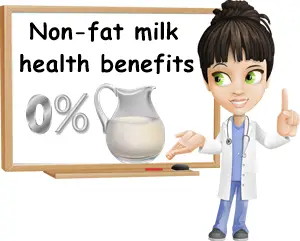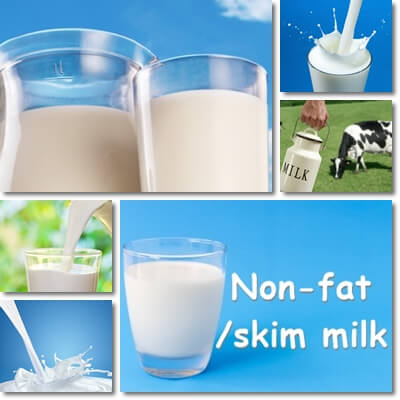What is non-fat milk more exactly? By definition, it is milk with less than 0.5% fat (ironic because it often does have some fat, albeit very small amounts). The terms non-fat, fat-free, skim or skimmed milk are often used interchangeably to refer to milk with less than 0.5% fat. However, in some countries, the terms skim or skimmed may be used to refer to milk with less than 0.3% fat or 0.1% fat only, while non-fat and fat-free and sometimes also skim and skimmed may refer to 0.1% and 0.0% fat milk only.
The terms ‘skim’ and ‘skimmed’ mean ‘to remove floating matter from a liquid’ and their use with relation to milk stems from the practice of removing the layer of butterfat that naturally rises at the surface of the liquid part of the milk. Non-fat milk is made by completely removing the naturally-occurring butterfat from the milk, then reintroducing very little of it (0.1% and up to 0.5%).

What percent is non-fat milk?
Typically less than 0.5%. Available options include 0.5%, 0.3%, 0.1% and 0.0% fat. Most commonly cow, goat and sheep milk. Water buffalo milk, although popular, is naturally high in fat (8 g of butterfat per 100 ml). Low-fat versions of this milk are 3% fat, about as much as regular, whole cow’s milk. To produce a non-fat version would mean to dilute the milk too much and have it lose too much of its nutritional value. Special types of milk, available only regionally, may qualify as low and non-fat. For example, donkey and horse milk are 0.3% to 1.8% fat naturally.
However, 0.0% or fat-free doesn’t necessarily mean there’s no butterfat at all in the milk, even if the packaging or label says so. It only means there’s less than 0.5% butterfat. Some countries allow producers to make such claims because an amount of milk fat as low as this isn’t believed to bring any significant nutritional contribution and is therefore considered a negligible amount (hence the label not always considering it). Still, it’s worth looking at the ingredients list where the exact amount of every ingredient is mentioned, even if it says otherwise on other parts of the package.
Types of non-fat/skim milk
- According to state: fluid and dry/powder milk.
- According to origin: cow, goat, sheep, water buffalo and regionally-available options (example: donkey, horse etc.)
- Pasteurized or unpasteurized. It’s unlikely you’ll find unpasteurized (raw) skim milk, but it can be done. Pasteurization is usually a non-negotiable food safety requirement all milk producers abide by. It involves heating the milk above a certain temperature to destroy bacteria, molds and yeasts. The main goal is to make a safer food product and eliminate the risks for food-borne illness. Additional benefits include prolonging shelf life (up to 6-9 months if the milk is packaged in aseptic tetra-packs) and preventing spoilage.
- Ultra-pasteurized. UHT, meaning ultra-heat treatment or ultra-high temperature, is different from regular pasteurization in the sense that the milk is heated at higher temperatures which results in a more efficient elimination of microbes for better food safety and longer shelf life.
- Homogenized or un-homogenized. The first option is what you’re likely going to find. Homogenization refers to a mechanical process that breaks down the fat globules in the milk and reduces their size. This helps the fat better disperse through the liquid part and prevents it from separating and rising to the surface. It also uniformizes the consistency of the milk and improves its taste.
- Fortified or unfortified. Fortification refers to improving the nutritional value of the milk. It usually consists of vitamin fortification, notably the addition of fat-soluble vitamins A and D, sometimes also E. However, some producers may also add calcium or protein.

What does non-fat/skim milk taste like?
For the most part, it tastes lighter and less creamier than regular, whole milk. However, homogenization makes it delicately sweet and contributes to a pleasantly smooth texture or consistency.
Interesting nutritional facts about non-fat/skim milk
- Even though it’s labeled non-fat, it can contain up to 0.5% butterfat per total weight.
- It has a higher lactose content than both whole and low-fat versions.
- It has a higher potassium content than whole milk, but about the same as 1% and 2%.
- Unless fortified (nutritionally enriched), it has low amounts of vitamins A, D and E (these vitamins are normally found in the butterfat portion).
- Pasteurization and ultra-pasteurization deplete vitamin C content, greatly reduce vitamin B9 (folate) content as well as lower the amount of other B vitamins (B1, B2, B3, B6 and B12).
- It’s less satiating and filling due to having a low butterfat content. At the same time, it’s lower in calories (although it’s good to remember that a great deal of the energetic value comes not from the butterfat, but from carbohydrates/lactose content).
- It naturally has more potassium than whole and low-fat options, a sought-after nutritional property.
How much calories in non-fat/skim milk?
- Non-fat cow milk has 34-41 kcal per 100 ml and 83-101 kcal per cup (estimated at 245 g).
1% has about 48 kcal per 100 ml and 118 kcal per cup. - 2% has 51-56 kcal per 100 ml and 125-137 kcal per cup.
- Whole, 3.25% has 61 kcal per 100 ml and 149 kcal per cup.
- Whole, 3.7% has 64 kcal per 100 ml and 156 kcal per cup.
Nutritional values for the different types of milk courtesy of USDA (United States Department of Agriculture) Food Composition Databases.
How much potassium is in non-fat/skim cow milk compared to 1%, 2% and whole?
- Non-fat: 156 mg of potassium per 100 ml; 382 mg per cup (245 g).
166 mg of potassium per 100 ml; 410 mg per cup (247 g).
And up to 182 mg of potassium per 100 ml; 448 mg per cup (246 g). - (1%): 180 mg of potassium per 100 ml; 443 mg per cup (246 g).
- (2%): 162 mg of potassium per 100 ml; 397 mg per cup (245 g).
And up to 182 mg of potassium per 100 ml; 446 mg per cup (245 g). - Whole (3.25%): 132 mg of potassium per 100 ml; 322 mg per cup (244 g).
Whole (3.7%): 151 mg of potassium per 100 ml; 368 mg per cup (244 g).
Potassium content also varies naturally in milk and is dependent on cattle diets, state of health and other factors. But, in general, the lower fat milk options tend to have a higher content. Also, goat milk has more potassium than cow and sheep.
Other nutrients in non-fat milk (notably the minerals calcium, magnesium, phosphorus, zinc) do not vary according to butterfat content. But, as mentioned above, vitamins A, D and E are affected by the removal of butterfat. Fortunately, they are returned through fortification. Another important nutrition fact regards B vitamins, especially vitamins B9 and B12, which are affected by heat treatment (pasteurization) and not usually returned to the milk through fortification (unless specified on the label).
In what way is non-fat milk good for you?
Benefits that can be derived from moderate consumption include:
- Better blood pressure numbers. Given its higher potassium content, non-fat milk helps combat high blood pressure. One cup provides up to 10% of the recommended daily intake of the mineral for an average adult (the goal intake being 47000 mg). Modest amounts of magnesium further contribute towards the benefits for hypertension. This is probably the biggest benefit of non-fat milk, one of immense importance for cardiovascular health, especially considering the general inadequate potassium intake worldwide.
- Retains good amounts of protein and all essential amino acids. Protein helps build muscle and repair damaged muscle fibers. The amino acids that make up protein help synthesize neurotransmitters in the brain that regulate mood, sleep, appetite and other processes. Some producers even fortify the milk with protein, raising protein content to 4 g in non-fat cow milk.
- Stronger bones and teeth, especially if fortified with calcium and vitamin D. While calcium is the building block of bones and teeth, vitamin D directs calcium absorption in bones. The modest phosphorus and magnesium amounts present naturally further help build and maintain bones and regulate nutrient absorption in them.
- Benefits for eyesight, skin and immunity from vitamin A fortified options. Vitamin A contributes to vision acuity and helps us see colors and in dim light. It’s know for reducing risks of early-onset macular degeneration, or loss of central vision due to aging. It also helps in the formation of new skin cells and coordinates their differentiation into specific types. It acts as an antioxidant for the skin with anti-aging benefits. Lastly, because of its skin-protective action which extends over mucous membranes, it plays a role in immunity.
- Benefits for skin from vitamins A, D and E, B vitamins and modest amounts of zinc. These include skin regeneration, anti-aging properties and improved ability of skin to retain moisture, contributing to better appearance. B vitamins further combat dry skin.
Just remember you need fat to absorb vitamin A. So make sure you get some from other sources of your choice. Healthy options include avocado (also good potassium source), eggs (source of Omega-3 and cholesterol for vitamin A absorption and protection of nerve cells), cheese (builds healthy gut bacteria populations), butter (so much vitamin A, plus fat to absorb it), nuts and seeds (if you’re not allergic; also major sources of fiber, minerals and vitamins) etc.
